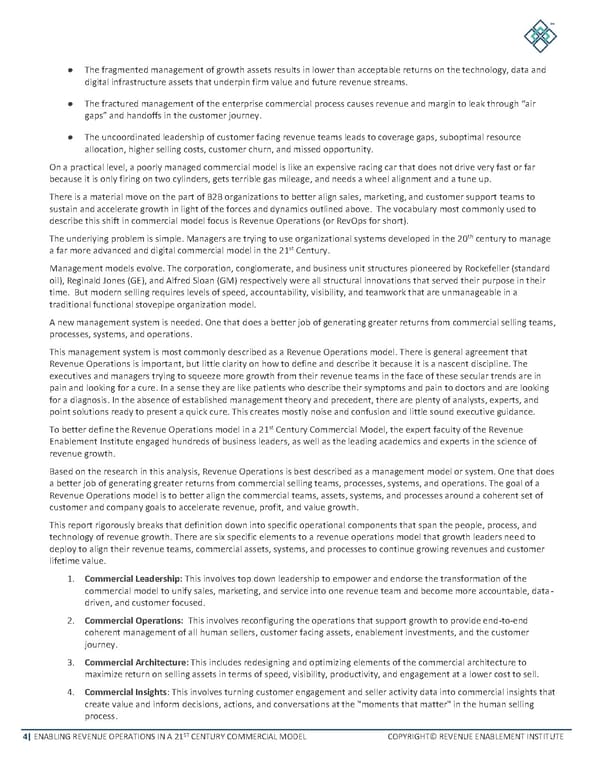4 | ENABLING REVENUE OPERATIONS IN A 21 ST CENTURY COMMERCIAL MODEL COPYRIGHT © REVENUE ENABLEMENT INSTITUT E ● The fragmented management of growth assets results in lower than acceptable returns on the technology, data and digital infrastructure assets that underpin firm value and future revenue streams. ● The fractured management of the e nterprise commercial process causes revenue and margin to leak through “air gaps” and handoffs in the customer journey. ● The uncoordinated leadership of customer facing revenue teams leads to coverage gaps, suboptimal resource allocation, higher selling c osts, customer churn, and missed opportunity. On a practical level, a poorly managed commercial model is like an expensive racing car that does not drive very fast or far because it is only firing on two cylinders, gets terrible gas mileage, and needs a wh eel alignment and a tune up. There is a material move on the part of B2B organizations to better align sales, marketing, and customer support teams to sustain and accelerate growth in light of the forces and dynamics outlined above. The vocabulary most co mmonly used to describe this shift in commercial model focus is Revenue Operations (or RevOps for short). The underlying problem is simple. Managers are trying to use organizational systems developed in the 20 th century to manage a far more advanced and di gital commercial model in the 21 st Century. Management models evolve. The corporation, conglomerate, and business unit structures pioneered by Rockefeller (standard oil), Reginald Jones (GE), and Alfred Sloan (GM) respectively were all structural innovatio ns that served their purpose in their time. But modern selling requires levels of speed, accountability, visibility, and teamwork that are unmanageable in a traditional functional stovepipe organization model. A new management system is needed. One that d oes a better job of generating greater returns from commercial selling teams, processes, systems, and operations. This management system is most commonly described as a Revenue Operations model. There is general agreement that Revenue Operations is importa nt, but little clarity on how to define and describe it because it is a nascent discipline. The executives and managers trying to squeeze more growth from their revenue teams in the face of these secular trends are in pain and looking for a cure. In a sens e they are like patients who describe their symptoms and pain to doctors and are looking for a diagnosis. In the absence of established management theory and precedent, there are plenty of analysts, experts, and point solutions ready to present a quick cur e. This creates mostly noise and confusion and little sound executive guidance. To better define the Revenue Operations model in a 21 st Century Commercial Model, the expert faculty of the Revenue Enablement Institute engaged hundreds of business leaders, a s well as the leading academics and experts in the science of revenue growth. Based on the research in this analysis, Revenue Operations is best described as a management model or system. One that does a better job of generating greater returns from commercial selling teams, processes, systems, and operations. The goal of a Revenue Operations model is to better align the commercial teams, assets, systems, and processes around a coherent set of customer and company goals to accelerate revenue, profit, and value growth. This report rigorously breaks that definition down into specific operational components that span the people, process, and technology of revenue growth. There are six specific elements to a revenue operations model that growth leaders nee d to deploy to align their revenue teams, commercial assets, systems, and processes to continue growing revenues and customer lifetime value. 1. Commercial Leadership: This involves top down leadership to empower and endorse the transformation of the commerc ial model to unify sales, marketing, and service into one revenue team and become more accountable, data - driven, and customer focused. 2. Commercial Operations: This involves reconfiguring the operations that support growth to provide end - to - end coherent ma nagement of all human sellers, customer facing assets, enablement investments, and the customer journey. 3. Commercial Architecture: This includes redesigning and optimizing elements of the commercial architecture to maximize return on selling assets in term s of speed, visibility, productivity, and engagement at a lower cost to sell. 4. Commercial Insights : This involves turning customer engagement and seller activity data into commercial insights that create value and inform decisions, actions, and conversatio ns at the "moments that matter" in the human selling process.
 Executive Summary Page 3 Page 5
Executive Summary Page 3 Page 5